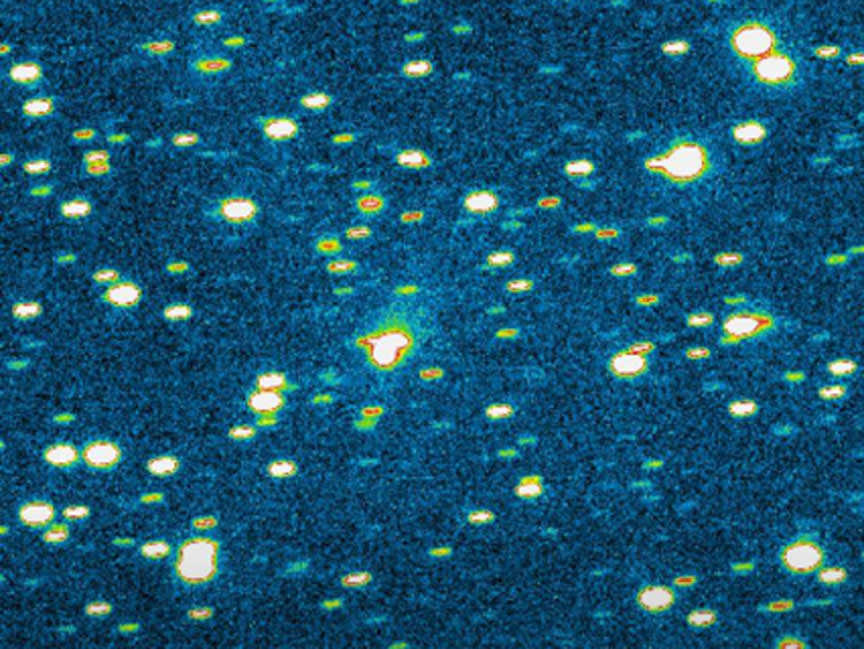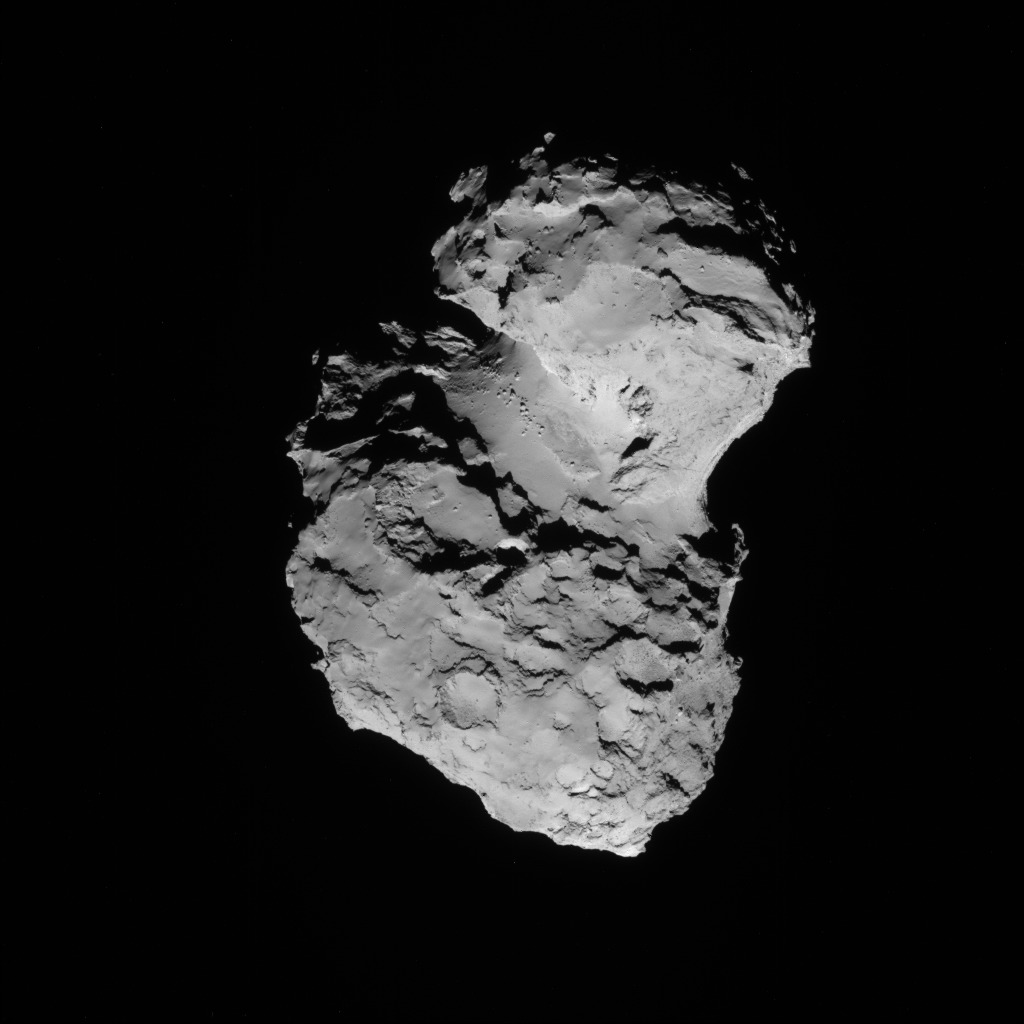It’s confirmed! Australian amateur astronomer Terry Lovejoy just discovered his fifth comet, C/2014 Q2 (Lovejoy). He found it August 17th using a Celestron C8 fitted with a CCD camera at his roll-off roof observatory in Brisbane, Australia.

“I take large sets of image triplets, i.e 3 images per star field and use software to find moving objects,” said Lovejoy. “The software I use outputs suspects that I check manually by eye.”
Most of what pops up on the camera are asteroids, known comets, or false alarms but not this time. Lovejoy’s latest find is a faint, fuzzy object in the constellation Puppis in the morning sky.
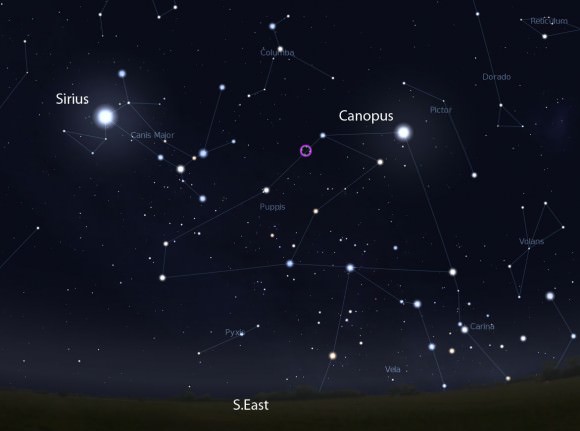
Glowing a dim magnitude +15, the new comet will be a southern sky object until later this fall when it swings quickly northward soon around the time of perihelion or closest approach to the sun. Lovejoy’s find needs more observations to better refine its orbit, but based on preliminary data, Maik Meyer, founder of the Comets Mailing List, calculates a January 2, 2015 perihelion.
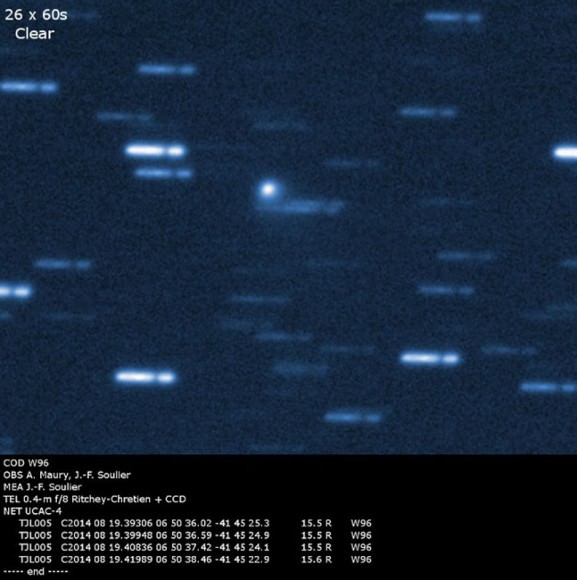
On that date, it will be a healthy 84 million miles from the sun, but one month earlier on December 7, the comet could pass just 6.5 million miles from Earth and be well placed for viewing in amateur telescopes.
Everything’s still a little up in the air right now, so these times and distances are likely to change as fresh observations pour in. Take all predictions with a major grain of salt for the moment.
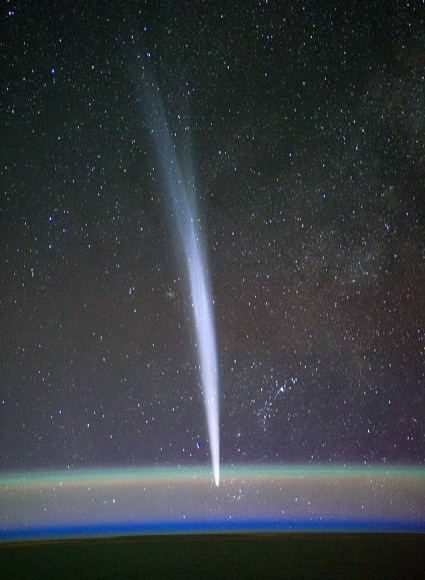
You might remember some of Terry’s earlier comets. Comet Lovejoy (C/2011 W3), a Kreutz sungrazer discovered in November 2011, passed just 87,000 miles above the sun’s surface. Many astronomers thought it wouldn’t survive the sun’s heat, yet amazingly, although much of its nucleus burned off, enough material survived to produce a spectacular tail.
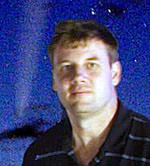
More recently, Comet Lovejoy (C/2013 R1) thrilled observers as it climbed to naked eye brightness last November, managing to do the impossible at the time and draw our eyes away from Comet ISON.
Congratulations Terry on your new find! May it wax brightly this fall.
* Update: The latest orbit calculation from the Minor Planet Center based on 24 observations now puts perihelion at 164.6 million miles (265 million km) on February 14, 2015. Closest approach to Earth of 93.2 million miles (150 million km) will occur in January.
Gravity Isn’t The Only Thing Holding Asteroids Together: Study
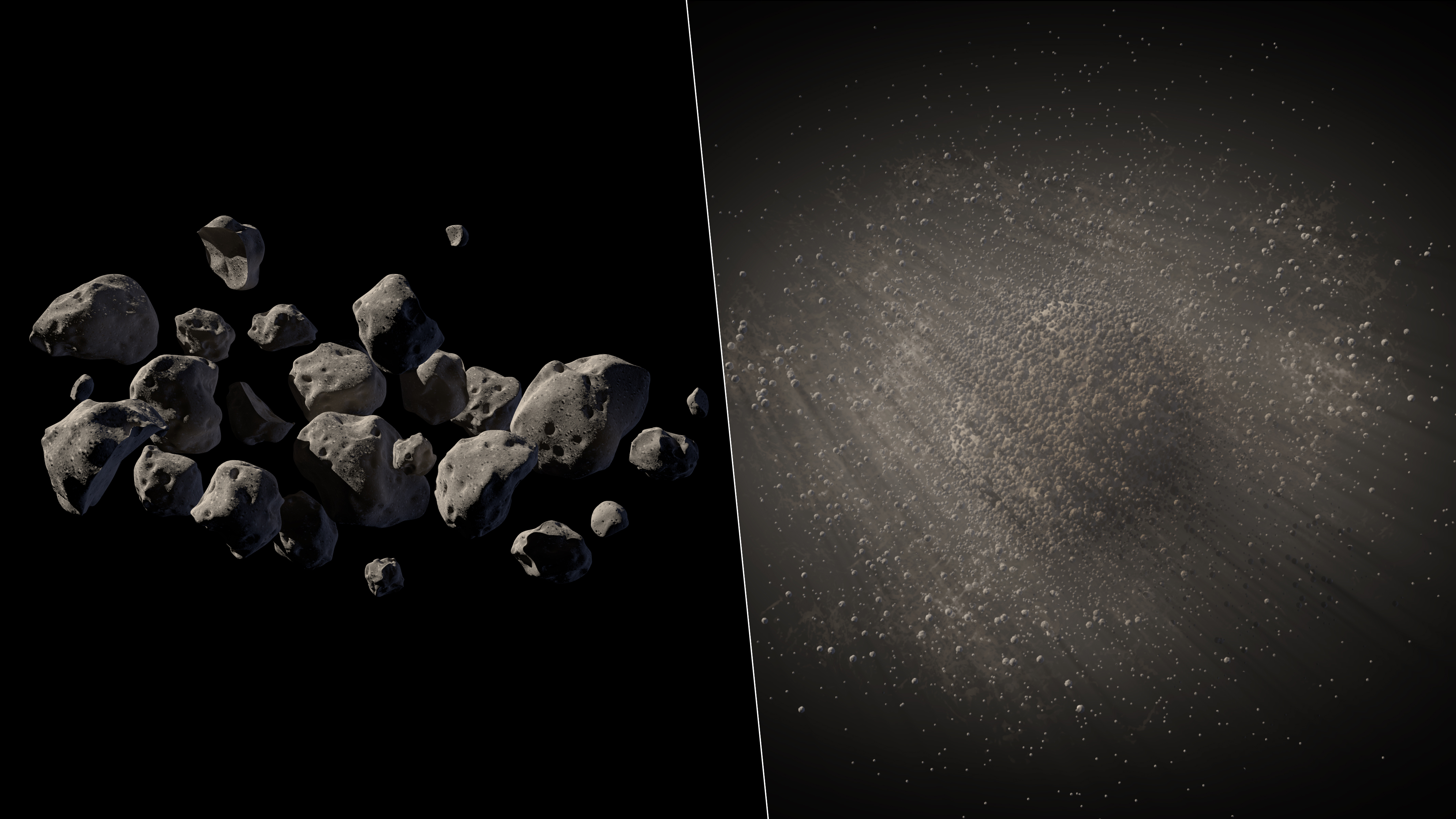
How do asteroids hold their rubble piles together? Previously, scientists said it was a combination of friction and gravity. But new observations of asteroid 1950 DA reveals something else is at work. The asteroid is rotating too quickly for gravity to keep it together, so what’s going on?
“We found that 1950 DA is rotating faster than the breakup limit for its density,” stated Ben Rozitis, a postdoctoral researcher at the University of Tennessee, Knoxville who led the research. “So if just gravity were holding this rubble pile together, as is generally assumed, it would fly apart. Therefore, interparticle cohesive forces must be holding it together.”
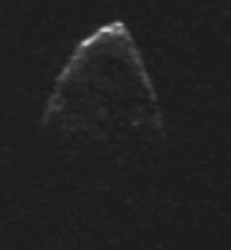
Cohesive forces refer to the act of individual molecules or particles sticking together. It’s the first time scientists have found this in action on an asteroid. Better yet, if confirmed in other asteroids this has implications for protecting Earth from a killer asteroid should one come our way.
If the threat turns out to be a loosely held together asteroid, an impact in just the right spot would break the single asteroid into many. (Of course, you’d want to make sure that the problem doesn’t end up turning into multiple smaller asteroids hitting Earth instead of a single large one.)
Now the researchers are interested in knowing if cohesive forces are also in action on Comet 67P/Churyumov–Gerasimenko — the comet being examined by Rosetta right now and in November, by the lander Philae.
The study was published in the journal Nature.
Rosetta’s Comet, Now in 3-D
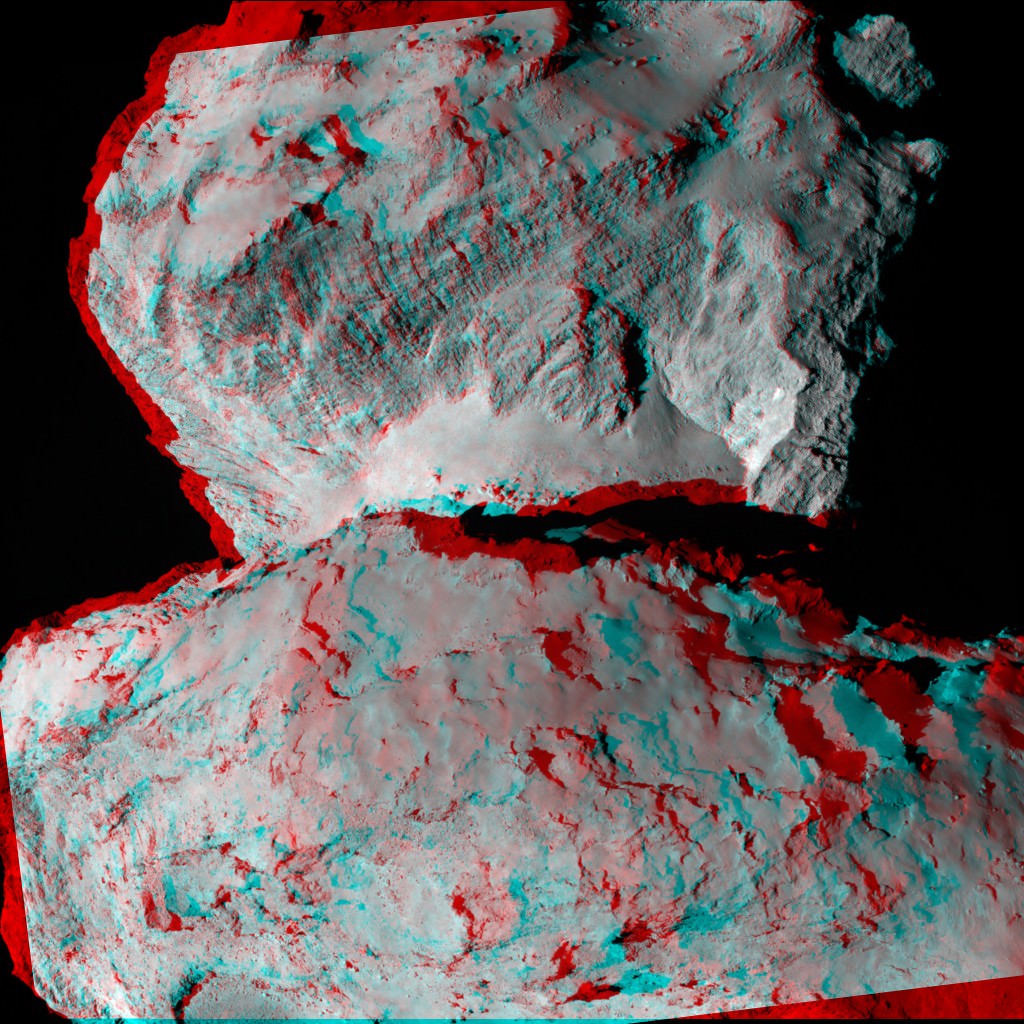
You always have a pair of those cardboard red-blue 3-D glasses by your desk, right? Well, grab them and take a look at this view of Comet 67P/Churyumov-Gerasimenko, just out from the Rosetta mission team. It almost feels like you’re right there with the spacecraft.
Notice the cliffs (see the exposed layers there?), boulders and depressions. The 3-D image was created using two images (you can see the two images here at the ESA blog) They were both taken on 7 August 2014, from a distance of 104 kilometres through the orange filter of the OSIRIS narrow-angle camera. ESA says the two images are separated by 17 minutes and the exposure time is 138 milliseconds.
Rosetta’s Comet Already Spewing Dust, One Year Before Getting Close To The Sun
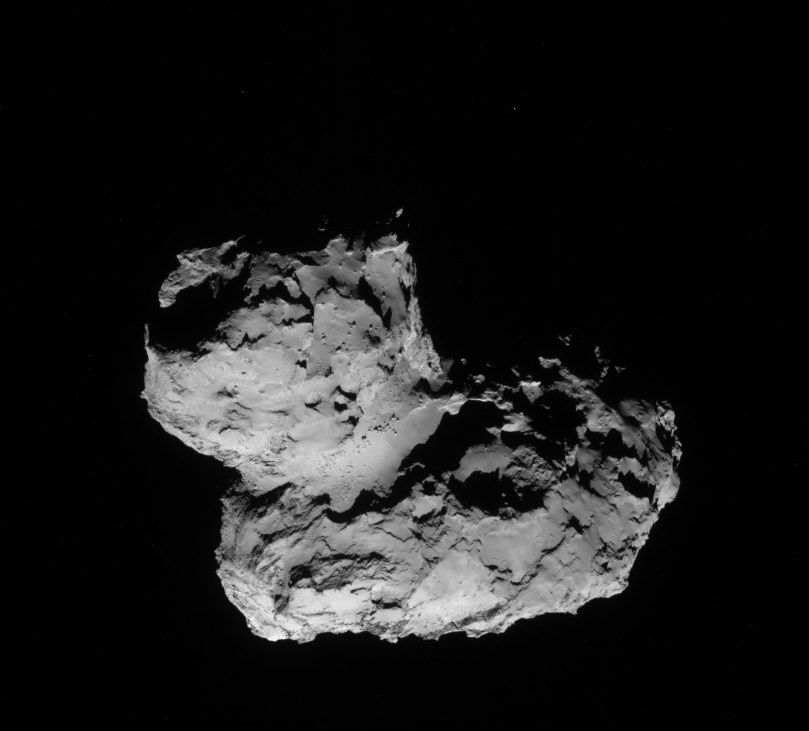
Mark your calendars, astronomy geeks: exactly one year from today, the comet the Rosetta spacecraft is chasing will make its closest approach to the Sun. As Comet 67P/Churyumov–Gerasimenko draws closer to the star, the radiation pressure will cause gas, ice and dust to stream off the comet in ever greater quantities, scientists expect.
But that process is already starting. Preliminary measurements by a dust detector aboard the Rosetta spacecraft show that dust is at least as frequent — or perhaps even more abundant — than what models have predicted. Meanwhile, as reported on Universe Today earlier this week, Rosetta’s COSIMA instrument is also doing dust measurements.
Rosetta’s Grain Impact Analyser and Dust Accumulator (GIADA) has already detected four dust grains on its impact sensor. The detections took place between Aug. 1 and Aug. 5 at various distances as Rosetta approached the comet, starting from as far as 814 kilometers (506 miles) to as close as 179 kilometers (111 miles). Rosetta arrived at the comet on Aug. 6.
The first impact was just a tad higher than the detection limit for GIADA, scientists said. They also estimated how big the grains are based on how quickly they crash into the impact detector — anywhere from tens of microns (the width of a human hair) to a few hundreds of microns across.
While the results are scientifically interesting, the European Space Agency pointed out that they will also have practical use.
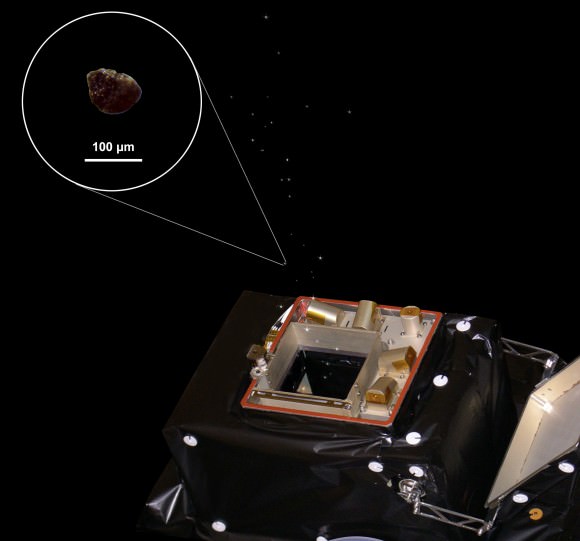
A lander called Philae is expected to touch down on the comet in November, so dust predictions will help planning for that. And for Rosetta itself, knowing the dust environment can help protect the spacecraft from strikes.
“GIADA will also provide inputs to other instruments on-board Rosetta, and will help improve coma dust models in support of the Philae landing operations,” ESA stated.
“Furthermore, GIADA will play an important role for the health and the safety of Rosetta and its instruments, providing information about the deposition rates of dust on optical components and critical parts of the spacecraft, such as the solar panels.”
ESA added that the grains themselves are likely a mixture of silicates, organics and some other stuff. Ice from the nucleus surrounds the grains, and the ice itself becomes a gas when the Sun warms the comet. Dust surrounds the comet in a coma and as it gets closer to the Sun, it streams out as a tail.
Source: European Space Agency
Some Of Comet ISON’s Organic Materials Arose In An Unexpected Place
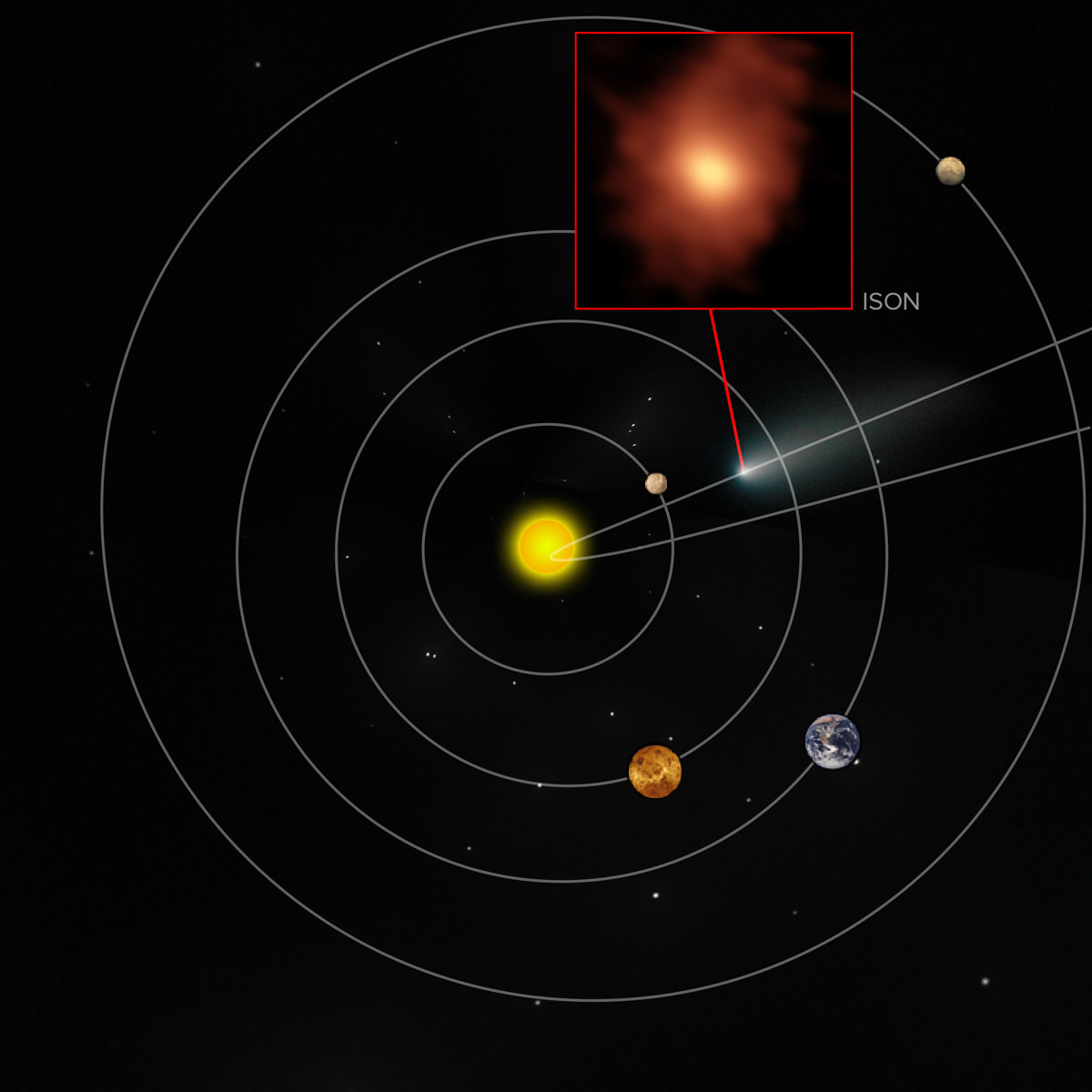
While Comet ISON’s breakup around Thanksgiving last year disappointed many amateur observers, its flight through the inner solar system beforehand showed scientists something neat: it was carrying organic materials with it.
A group examined the molecules surrounding the comet in its coma (atmosphere) and, along with observations of Comet Lemmon, created a 3-D model that you can see above. Among other results, this revealed the presence of formaldehyde and HNC (hydrogen, nitrogen and carbon). The formaldehyde was expected, but the spot where HNC was found came as a surprise.
Scientists used to think that HNC is produced from the nucleus, but the research revealed that it actually happens when larger molecules or organic dust breaks down in the coma.
“Understanding organic dust is important, because such materials are more resistant to destruction during atmospheric entry, and some could have been delivered intact to early Earth, thereby fueling the emergence of life,” stated Michael Mumma, a co-author on the study who is director of the Goddard Center for Astrobiology. “These observations open a new window on this poorly known component of cometary organics.”
Observation were made possible using the powerful Atacama Large Millimeter/submillimeter Array (ALMA). The array of 66 radio telescopes in Chile allows astronomers to map molecules and peer past dust clouds in star systems under formation, among other things. ALMA was completed last year and is the largest telescope of its type in the world.
The array’s resolution allowed scientists to probe for these molecules in moderately bright comets, which is also new. Previously, these types of studies were limited to “blockbuster” visitors such as Comet Hale-Bopp in the 1990s, NASA sated.
The study, which was led by the Goddard Center for Astrobiology’s Martin Cordiner at NASA’s Goddard Space Flight Center, was published in Astrophysical Journal Letters. The research is also available in preprint version on Arxiv.
Source: NASA
Coma Dust Collection Science starts for Rosetta at Comet 67P/Churyumov-Gerasimenko
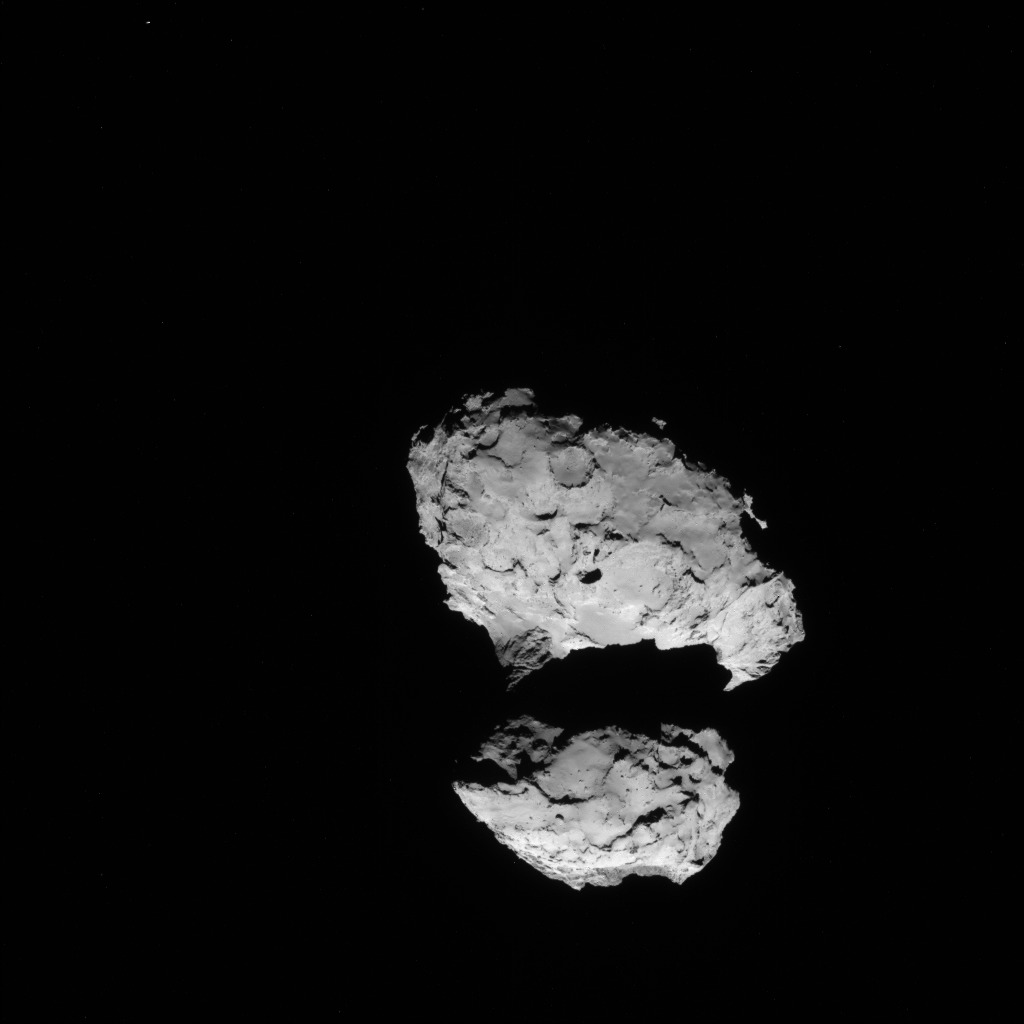
With the historic arrival of the European Space Agency’s (ESA) Rosetta spacecraft at destination Comet 67P/Churyumov-Gerasimenko flawlessly accomplished on August 6, 2014 after a decade long journey, ground breaking up close science at this bizarre world has begun while the team diligently and simultaneously searches for a landing site for the attached Philae comet lander.
Rosetta started collecting cometary dust from the coma encircling the comet’s nucleus with the onboard COSIMA instrument on Sunday, August 10, 2014 as the spacecraft orbits around and ahead of the icy wanderer from a distance of approximately 100 kilometers (62 miles). See coma image below.
Hopes are high that unprecedented science discoveries await at this alien world described as a “Scientific Disneyland,” by Mark McCaughrean, senior scientific adviser to ESA’s Science Directorate, during ESA’s live arrival day webcast. “It’s just astonishing.”
COSIMA stands for Cometary Secondary Ion Mass Analyser and is one of Rosetta’s suite of 11 state-of-the-art science instruments with a combined mass of 165 kg.
Its purpose is to conduct the first “in situ” analysis of the grains of dust particles emitted from the comets nucleus and determine their physical and chemical characteristics, including whether they are organic or inorganic – in essence what is cometary dust material made of and how it differs from the surface composition.
COSIMA will collect the coma dust using 24 specially designed ‘target holders’ – the first of which was opened to study the comets environment on Aug. 10. Since the comet is not especially active right now, the team plans to keep the target holder open for at least a month and check the progress of any particle collections on a weekly basis.
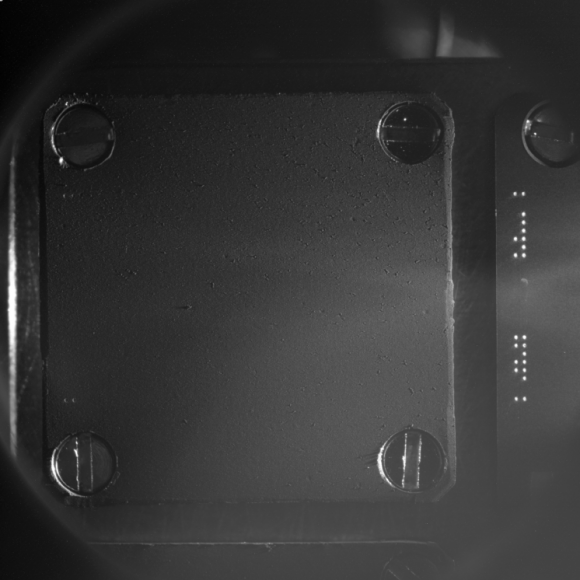
In fact the team says the coma environment “is still comparable to a high-quality cleanroom”at this time.
But everyone expects that to change radically as Rosetta continues escorting Comet 67P as it loops around the sun, getting closer and warming the surface every day and until reaching perihelion in August 2015.
COSIMA is managed by the Max Planck Institute for Solar System Research (Max-Planck-Institut für Sonnensystemforschung ) in Katlenburg-Lindau, Germany, with Principal Investigator Martin Hilchenbach.
There are also substantial contributions from the Institut d’Astrophysique Spatiale in France, Finnish Meteorological Institute, Osterreichisches Forschungszentrum Seibersdorf and more.
The target holders measure about one square centimeter and were developed by the Universität der Bundeswehr in Germany.
Each of these targets measures one square centimeter and is comprised of a gold plate covered with a thin 30 µm layer of gold nanoparticles (“gold black”) which the team says should “decelerate and capture cometary dust particles impacting with velocities of ~100 m/s.”
The target will be illuminated by a pair of LED’s to find the dust particles. The particles will be analyzed by COSIMA’s built in mass spectrometer after being located on the target holder by the French supplied COSISCOPE microscopic camera and ionized by a beam of indium ions.
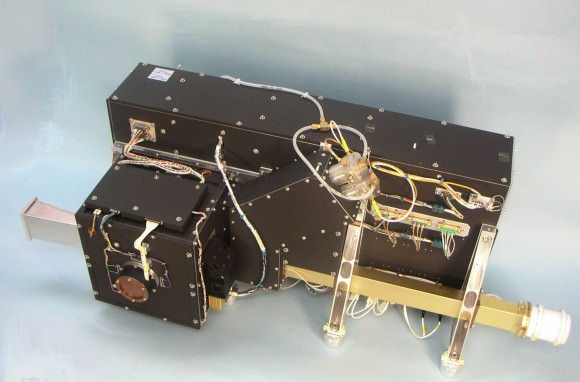
The team expects any grains found on the first target to be analyzed by mid-September 2014.
“COSIMA uses the method of Secondary Ion Mass Spectrometry. They will be fired at with a beam of Indium ions. This will spark individual ions (we say secondary ions) from their surfaces, which will then be analysed with COSIMA’s mass spectrometer,” according to a description from the COSIMA team.
The mass spec has the capability to analyze the elemental composition in an atomic mass range of 1 to 4000 atomic mass units, determine isotopic abundances of some key elements, characterize organic components and functional groups, and conduct mineralic and petrographic characterization of the inorganic phases, all of which will inform as as never before about solar system chemistry.
Comets are leftover remnants from the formation of the solar system. Scientists believe they delivered a vast quantity of water to Earth. They may have also seeded Earth with organic molecules – the building blocks of life as we know it.
Any finding of organic molecules and their identification by COSIMA will be a major discovery for Rosetta and ESA and inform us about the origin of life on Earth.
Data obtained so far from Rosetta’s VIRTIS instrument indicates the comets surface is too hot to be covered in ice and must instead have a dark, dusty crust.
Stay tuned here for Ken’s continuing Earth and Planetary science and human spaceflight news.
…….
Read my Rosetta series here:
What’s Ahead for Rosetta – ‘Finding a Landing Strip’ on Bizarre Comet 67P/Churyumov-Gerasimenko
Rosetta on Final Approach to Historic Comet Rendezvous – Watch Live Here
Rosetta Probe Swoops Closer to Comet Destination than ISS is to Earth and Reveals Exquisite Views
Rosetta Orbiter less than 500 Kilometers from Comet 67P Following Penultimate Trajectory Burn
Rosetta Closing in on Comet 67P/Churyumov-Gerasimenko after Decade Long Chase
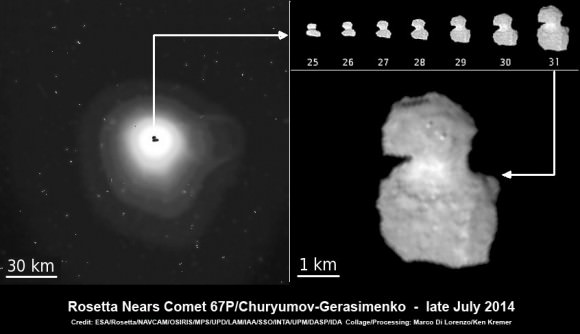
Photo Gallery: Step Right Up And Tour Rosetta’s Comet! Where Shall We Land?
What’s one of the first things you do when arriving at a new destination? Likely it would be scoping out the local neighborhood. Getting a sense of its terrain and the good things to do around there.
That’s part of what Rosetta’s team is working on since arriving at its comet early in the morning of Aug. 6 (Eastern time). While only a few pictures have been beamed back to the public so far of Comet 67P/Churyumov-Gerasimenko, the glimpses of its surface are tantalizing. Which is important, because a little spacecraft is on its way there.
As the team busily calibrates its instruments and snaps pictures of the surface, one of their first tasks will be to pick a landing site for Philae, the machine that is scheduled to leave Rosetta and actually touch softly down on the surface in November. This is the first time such a soft-landing has been attempted, and it’s been a long decade of waiting for the scientists who sent the two spacecraft on their way.
Picking a spot will be difficult for the team, they explained last week. The gravity is light and the terrain is not only difficult to navigate, but also hard to choose from. Would you prefer a crater or a cliff? That will be what science investigators will examine in the coming months.
As they do that, check out the latest pictures of the comet in the gallery below.
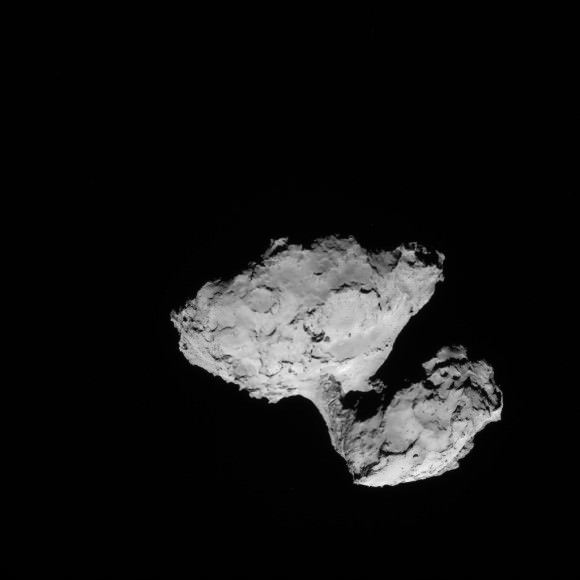
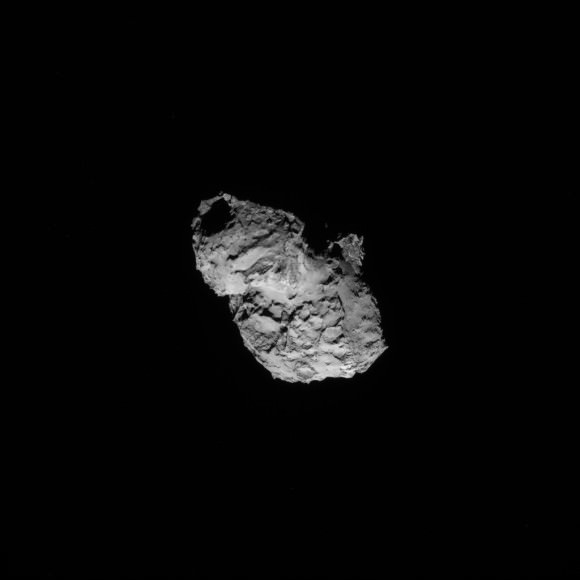
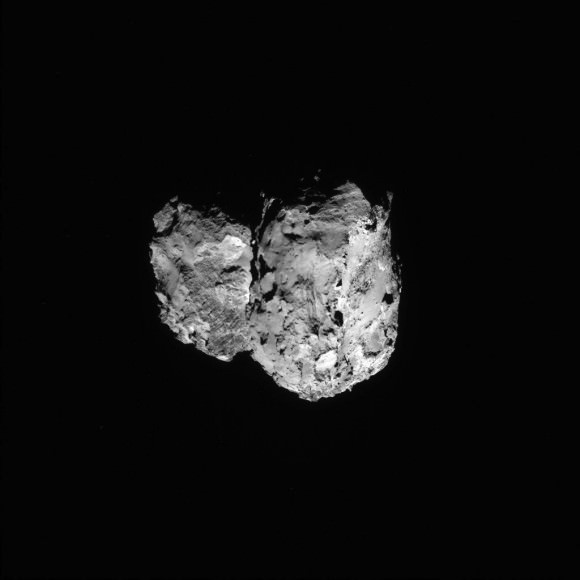
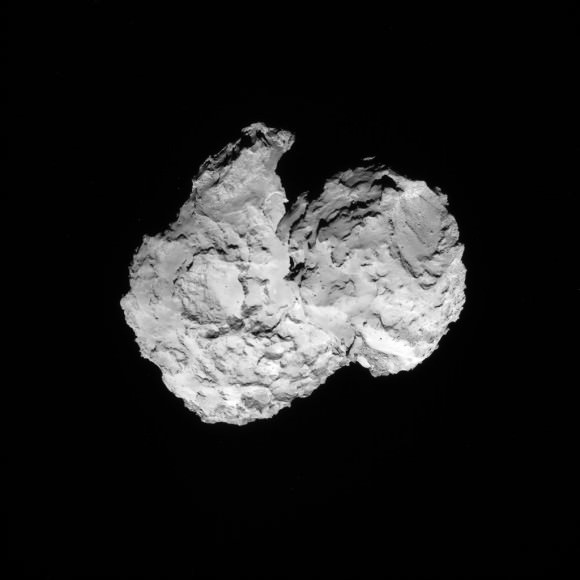
ISEE-3 Completes Lunar Flyby, Begins a Citizen Science Program
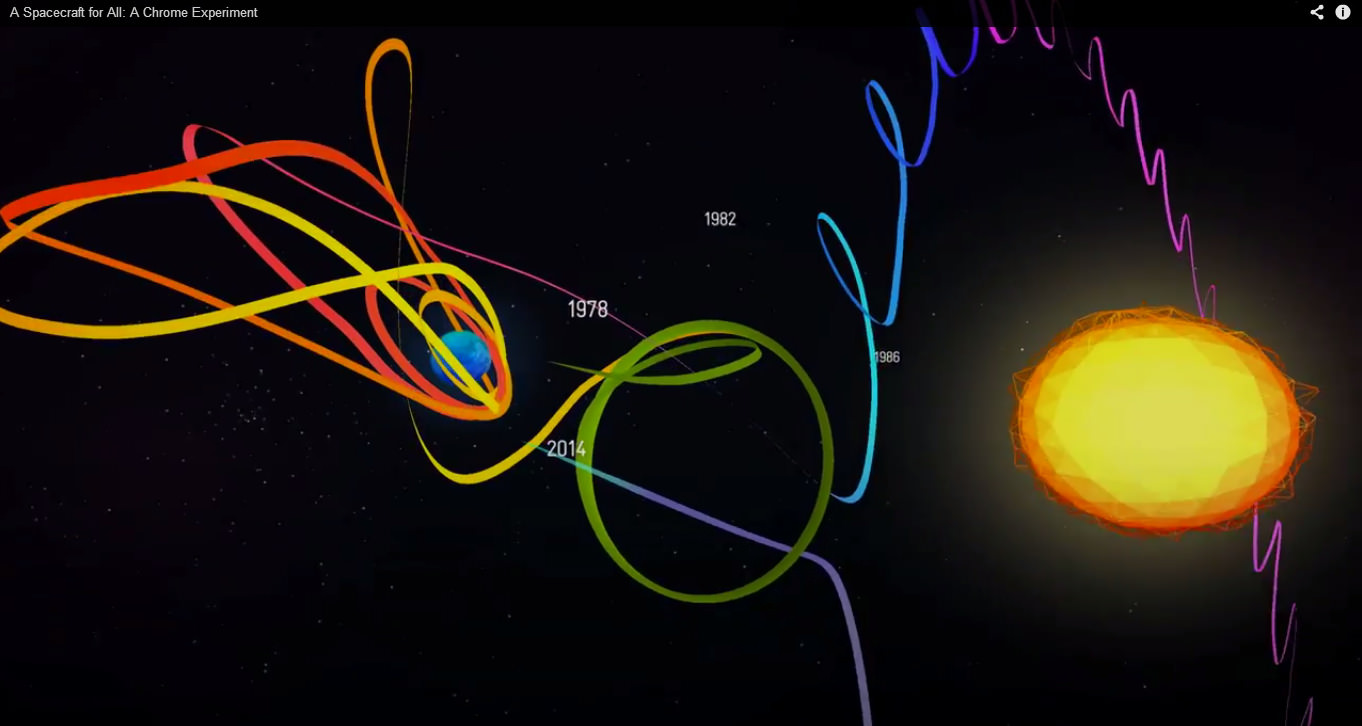
The journey began on August 12, 1978 from Cape Canaveral on a Delta II launch vehicle. Now after 36 years and 30 billions miles of travel around the Sun — as well as a crowd-funded reboot of the spacecraft and a foiled attempt to put it into Earth orbit — the ISEE-3 has completed a return visit to the Earth-Moon system.
The spacecraft made its closest approach to the Earth on August 9 and flyby of the Moon, August 10, 2014. Closest approach was 15,600 km (9693 miles) from the Moon’s surface. With the lunar flyby, Skycorp, Inc. of Mountain View, California, with help from Google Creative Labs, has announced a revised mission for ISEE-3 to deliver science to the public domain.
ISEE-3 has marked several important milestones and achievements for NASA over the five decades in which it has traveled and monitored the particles and fields between the Earth and the Sun. Its latest milestone – returning to Earth, was planned and refined over 30 years ago. However, with NASA no longer interested in recovering the spacecraft because of the limitations of its present budgets, its impending return would be with no fanfare, no commanding, no recovery into Earth orbit and no new mission. With the news that NASA could not afford a recovery, space enthusiasts began to talk. Retired and active aerospace engineers began to exchange ideas with avid HAM radio operators around the World. Finally, one group took charge. They revived the vintage spacecraft and has now designed a new mission for the it.
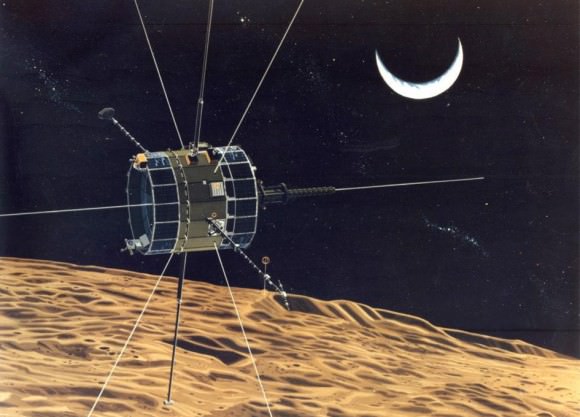
Enter Dennis Wingo and Austin Epps of Skycorp, Inc. Residing in an abandoned McDonald’s drive-thru on Moffett Field in Mountain View, California, they began a journey in March to recover the spacecraft. First off, before any recovery attempt could be undertaken, it required original documentation, so Dennis with assistance from Keith Cowing began contacting original ISEE-3 engineers, calling, knocking on NASA doors and finally began signing NASA space act agreements to have the documents released into their possession. And what fascinating documents they were.
Written long before the internet, before the first personal computers and when computer punch cards and main frames were the means to program and command spacecraft, most of the ISEE-3 documents resided as printed documents only, on none other than paper, yellowing and old, doomed to eventually rot away in modest storage rooms. Some had been converted to the modern archive format, Adobe’s PDF file format. This was the beginning of revival of a working knowledge to command the spacecraft. It was very sketchy but in about 90 days, documents appeared, documents were scanned to PDFs, searched and the team prepared for the recovery attempt.
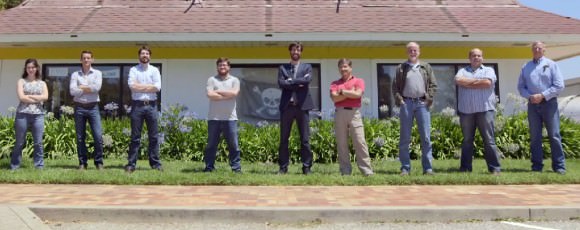
The team grew rapidly and as the Beatles song goes, Skycorp got by with a little help from their friends. Actually, a lot of help from their friends. First, there was a crowd funding effort. Thousands of individuals from around the globe contributed to a final crowd funding purse of about $160,000. This is in contrast to the $100 million or much more that is required to reach just the launch date of a NASA mission.
Next, the people that had been exchanging comments on blogs (e.g. Planetary blog post on ISEE-3) began making themselves available, no charge, providing decades of accrued experience in spacecraft design and operation and other very relevant expertise. There were original NASA engineers, Robert Farquhar and David Dunham, Warren Martin, Bobby Williams, and Craig Roberts. HAM radio operators appeared or were contacted from as far as England (AMSAT-UK), Germany(Bochum Obs.) and as nearby as the SETI Institute in Mountain View, California. All this expertise, working knowledge and capable hardware had to converge very rapidly. By the latter half of May, they were ready.
The operators of the venerable Arecibo Radio Telescope offered their expertise and its 1000 foot radio dish for communication purposes. And an absolutely critical solution was found to replace the lack of any existing transmitter that could communicate with the old 40 year old technology. NASA had retired and scrapped the original Deep Space Network equipment. So technology developed by Ettus Research Corp. of Santa Clara, California was identified as a possible replacement for the non-existent transmitter. Ettus proposed a combination of open source software called Gnu Radio configured to work with Ettus developed Universal Software Radio Peripheral (USRP) platforms as the solution. With the Skycorp team constructing the command sequences, Ettus engineers Balint Seeber and a former engineer John Marlsbury rigged the critical substitute for a hardware transmitter and with the expertise to modulate and demodulate a radio signal, a trip to Puerto Rico and the Arecibo dish was undertaken in May.
After two weeks of some waiting on hardware and trial and error, there was success. Two-way communication was achieved and ISEE-3 truly became ISEE-3 Reboot. Further hiccups unfolded by trial and error, learning to command and receive with still less than complete working knowledge. More NASA space act agreements were necessary to permit the access to achieve success. Finally, NASA provided time on the Deep Space Network, the famous Goldstone radio dish and others in the network, famous for communicating with Apollo missions and Voyagers at the edge of the Solar System. This provided further attempts at communication that helped to resolve and understand issues. Furthermore, a Bell Labs engineer, Phil Karn Jr. (KA9Q) volunteered his expertise in late night work sessions, to demodulate and decode the incoming radio signal, to convert analog signal into 1’s and 0’s. Phil provided crucial input and energy to the ISEE-3 Reboot at a key juncture.
The ultimate goal could now be attempted – command the spacecraft to fire its rocket engines to change its trajectory and become captured by the Earth’s gravitational field. Mike Loucks of Space Exploration Engineering and engineers of Applied Defense Solutions, Inc. worked quickly to provide trajectory information and revisions. Finally, commanding ISEE-3 to fire its rockets was attempted and then attempted again and again. Skycorp concluded that father time was what was truly in command of ISEE-3’s destiny. Thirty-six years in space had taken its toll and Skycorp engineers realized that the fuel tanks had lost pressure. They could command it in all necessary ways but the spacecraft could not squeeze the fuel out of the tanks.
Recovering from this disappointment, Skycorp has arrived at today with the help of the original engineers lead by Robert Farquhar of Goddard Space Flight Center, along with the thousands through crowd funding contributions and an incredible group of volunteers. And along the way, Google Creative Labs documented the adventure and created the compendium which was delivered to the public domain last week, A Spacecraft for All. This web site provides a graphic illustration of both the ISEE-3 timeline as well as its incredible journey to explore the Sun-Earth relationship, study two comets and then undertake a 30 year journey to return to Earth on August 10, 2014.
Using the radio telescope at Morehead State University, they will continue receiving the commanded telemetry stream from the remaining viable science instruments, process the data and present it to the public and to professional researchers alike for analysis. While ISEE-3 could not be recovered into an Earth orbit as Farquhar had hoped decades ago, it will continue its journey around the Sun and return to the vicinity of the Earth in 2029. How long telemetry from ISEE-3 can be received as it travels away from the Earth remains to be seen, and keeping in contact with it will be a challenge for its new operators in the months ahead.
Watch the video below about the project:
What’s Ahead for Rosetta – ‘Finding a Landing Strip’ on Bizarre Comet 67P/Churyumov-Gerasimenko
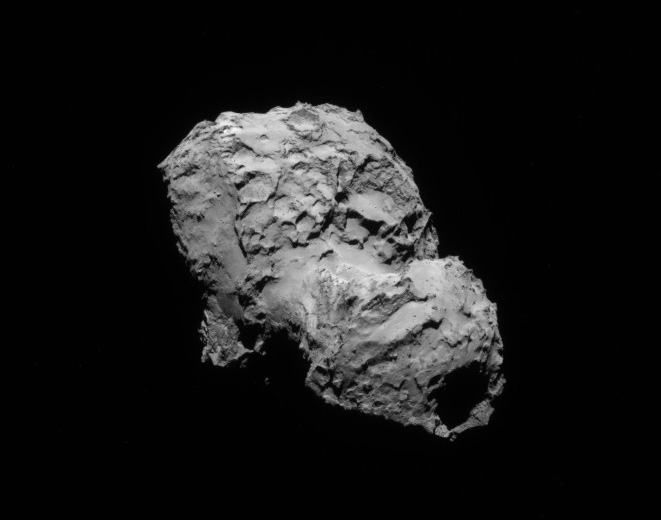
Where would you land here?
Newly released NAVCAM image taken by Rosetta on 5 August 2014 from a distance of about 145 km from comet 67P/Churyumov-Gerasimenko. Image has been rotated 180 degrees. Credit: ESA/Rosetta/NAVCAM[/caption]
Following the flawless and history making arrival of the European Space Agency’s (ESA) Rosetta spacecraft at its long sought destination of Comet 67P/Churyumov-Gerasimenko on Wednesday, Aug. 6, the goal of conducting ground breaking science at this utterly alien and bizarre icy wanderer that looks like a ‘Scientific Disneyland’ can actually begin.
Rosetta is the first spacecraft in history to rendezvous with a comet and enter orbit – after a more than 10 year chase of 6.4 billion kilometers (4 Billion miles) along a highly complex trajectory from Earth. The arrival event was broadcast live from mission control at ESA’s spacecraft operations centre (ESOC) in Darmstadt, Germany. Read my complete arrival story – here.
So what’s ahead for Rosetta? Another audacious and history making event – Landing on the comet!
A top priority task is also another highly complex task – ‘Finding a landing strip’ on the bizarre world of Comet 67P for the piggybacked Philae comet lander equipped with 10 science instruments.
“The challenge ahead is to map the surface and find a landing strip,” said Andrea Accomazzo, ESA Rosetta Spacecraft Operations Manager, at the Aug. 6 ESA webcast.
That will be no easy task based on the spectacular imagery captured by the OSIRIS high resolution science camera and the Navcam camera that has revealed an utterly wacky and incredibly differentiated world like none other we have ever visited or expected when the mission was conceived.
Magnificently detailed new navcam images were released by ESA today, Aug, 7, streaming back to Earth across some 405 million kilometers (250 million miles) of interplanetary space – see above and below.
The team will have its hand full trying to find a safe spot for touchdown.
“We now see lots of structure and details. Lots of topography is visible on the surface,” said Holger Sierks, principal investigator for Rosetta’s OSIRIS camera from the Max Planck Institute for Solar System Research in Gottingen, Germany, during the webcast.
“There is a big depression and 150 meter high cliffs, rubble piles, and also we see smooth areas and plains. It’s really fantastic”
“We see a village of house size boulders. Some about 10 meters in size and bigger and they vary in brightness. And some with sharp edges. We don’t know their composition yet,” explained Sierks.
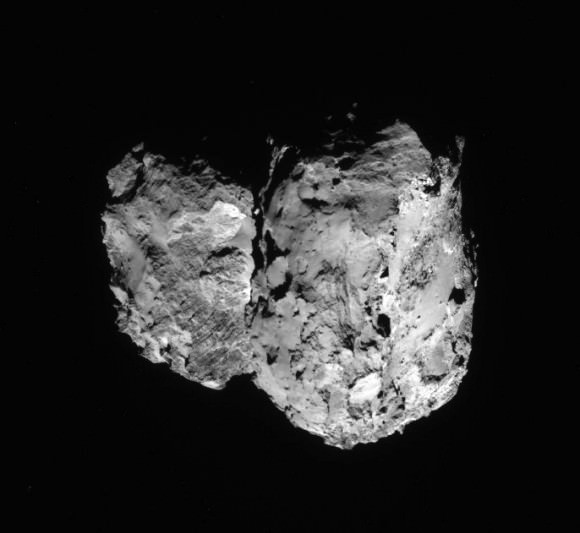
The key to finding a safe landing site for Philae will be quickly conducting a global comet mapping campaign with OSIRIS, Navcam and the remaining suite of 11 science instruments to provide a detailed scientific study of the physical characteristics and chemical composition of the surface.
They also need to determine which areas are hard or soft.
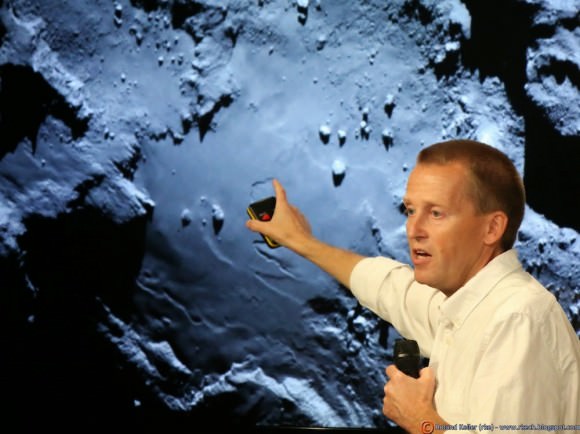
“Our first clear views of the comet have given us plenty to think about,” says Matt Taylor, ESA’s Rosetta project scientist.
“Is this double-lobed structure built from two separate comets that came together in the Solar System’s history, or is it one comet that has eroded dramatically and asymmetrically over time? Rosetta, by design, is in the best place to study one of these unique objects.”
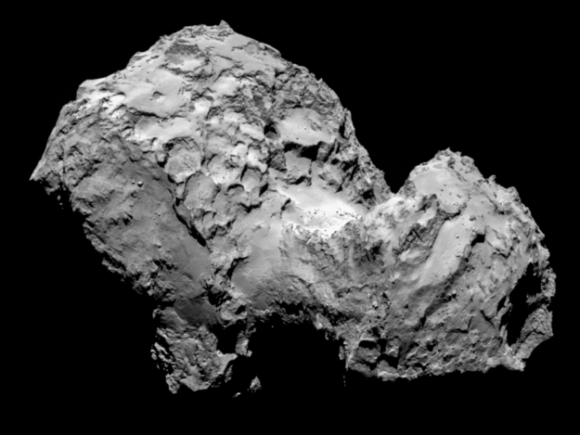
Yesterday’s (Aug. 6) critical final thruster firing placed the 1.3 Billion euro robotic emissary from Earth into a triangular shaped orbit about 100 kilometers (62 miles) above and in front of the comet’s incredibly varied surface.
Therefore the initial mapping will be conducted from the 100 km (62 mi.) standoff distance.
Since the landing is currently targeted for November 11, 2014, in barely three months time there is not a moment to waste.
“Over the next few months, in addition to characterizing the comet nucleus and setting the bar for the rest of the mission, we will begin final preparations for another space history first: landing on a comet,” says Taylor.
The team will identify up to five possible landing sites by late August and expect to choose the primary site by mid-September.
Then the team has to plan and build the programming and maneuvers for the final timeline to implement the sequence of events leading to the nailbiting landing.
With Rosetta now travelling in a series of 100 kilometer-long (62 mile-long) triangular arcs in front of the comet lasting about 3 days each, it will also be firing thrusters at each apex.
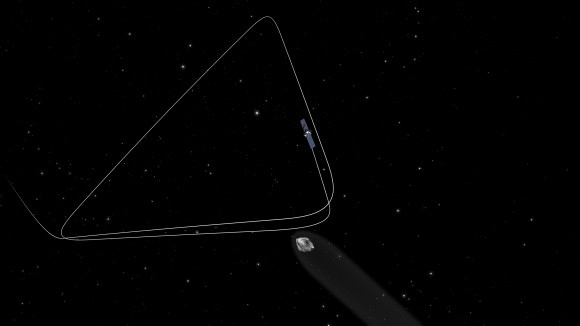
But it will also gradually edge closer over the next six weeks to about 50 km distance and then even closer to lower Rosetta’s altitude about Comet 67P until the spacecraft is captured by the comet’s gravity.
In November 2014, Rosetta will attempt another historic first when it deploys the Philae science lander from an altitude of just about 2.5 kilometers above the comet for the first ever attempt to land on a comet’s nucleus.
The three-legged lander will fire harpoons and use ice screws to anchor itself to the 4 kilometer (2.5 mile) wide comet’s surface. Philae will collect stereo and panoramic images and also drill into and sample its incredibly varied surface.
How will Philae land?
Stefan Ulamec, Philae Lander Manager from the German Aerospace Center (DLR) talked about the challenges of landing in a low gravity environment during the ESA webcast.
“The touchdown will be at a speed of just 1 m/s,” Ulamec explained. “This is like walking and bouncing against a wall.”
Details in an upcoming story!
Why study comets?
Comets are leftover remnants from the formation of the solar system. Scientists believe they delivered a vast quantity of water to Earth. They may have also seeded Earth with organic molecules.
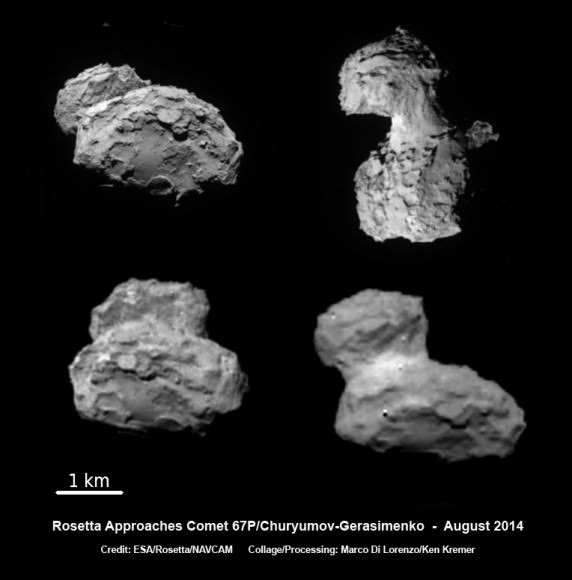
Stay tuned here for Ken’s continuing Rosetta, Curiosity, Opportunity, Orion, SpaceX, Boeing, Orbital Sciences, commercial space, MAVEN, MOM, Mars and more Earth and Planetary science and human spaceflight news.
…….
Read my Rosetta series here:
Rosetta on Final Approach to Historic Comet Rendezvous – Watch Live Here
Rosetta Probe Swoops Closer to Comet Destination than ISS is to Earth and Reveals Exquisite Views
Rosetta Orbiter less than 500 Kilometers from Comet 67P Following Penultimate Trajectory Burn
Rosetta Closing in on Comet 67P/Churyumov-Gerasimenko after Decade Long Chase

Rosetta Arrives at ‘Scientific Disneyland’ for Ambitious Study of Comet 67P/Churyumov-Gerasimenko after 10 Year Voyage

The image of Comet 67P/Churyumov-Gerasimenko was taken by Rosetta’s OSIRIS narrow-angle camera on 3 August 2014 from a distance of 285 km. Credits: ESA/Rosetta/MPS for OSIRIS Team MPS/UPD/LAM/IAA/SSO/INTA/UPM/DASP/IDA
Story updated[/caption]
“We’re at the comet! Yes,” exclaimed Rosetta Spacecraft Operations Manager Sylvain Lodiot, confirming the spacecraft’s historic arrival at Comet 67P/Churyumov-Gerasimenko during a live webcast this morning, Aug. 6, from mission control at ESA’s spacecraft operations centre (ESOC) in Darmstadt, Germany.
The European Space Agency’s (ESA) Rosetta comet hunter successfully reached its long sought destination after a flawless orbital thruster firing at 11 AM CEST to become the first spacecraft in history to rendezvous with a comet and enter orbit aimed at an ambitious long term quest to produce ground breaking science.
“Ten years we’ve been in the car waiting to get to scientific Disneyland and we haven’t even gotten out of the car yet and look at what’s outside the window,” Mark McCaughrean, senior scientific adviser to ESA’s Science Directorate, said during today’s webcast. “It’s just astonishing.”
“The really big question is where did we and the solar system we live in come from? How did water and the complex organic molecules that build up life get to this planet? Water and life. These are the questions that motivate everybody.”
“Rosetta is indeed the ‘rosetta stone’ that will unlock this treasure chest to all comets.”
Today’s rendezvous climaxed Rosetta’s decade long and 6.4 billion kilometers (4 Billion miles) hot pursuit through interplanetary space for a cosmic kiss with Comet 67P while speeding towards the inner Solar System at nearly 55,000 kilometers per hour.
The probe is sending back spectacular up close high resolution imagery of the mysterious binary, two lobed comet, merged at a bright band at the narrow neck of the celestial wanderer that looks like a ‘rubber ducky.’
“This is the best comet nucleus ever resolved in space with the sharpest ever views of the nucleus, with 5.5.meter pixel resolution,” said Holger Sierks, principal investigator for Rosetta’s OSIRIS camera from the Max Planck Institute for Solar System Research in Gottingen, Germany, during the webcast.
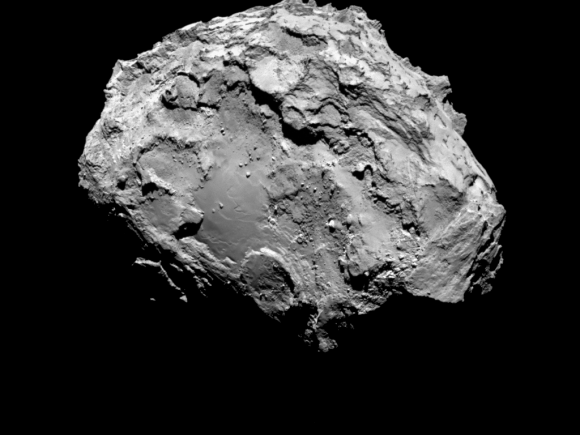
“We now see lots of structure and details. Lots of topography is visible on the surface. We see the nucleus and outgassing activity. The outbursts are seen with overexposed images. It’s really fantastic”
“There is a big depression on the head and 150 meter high cliffs, rubble piles, and also we see smooth areas and plains. The neck is about 1000 meters deep and is a cool area. There is outgassing visible from the neck.”
“We see a village of house size boulders. Some about 10 meters in size and bigger they vary in brightness. And some with sharp edges. We don’t know their composition yet.”
“We don’t understand how its created yet. That’s what we’ll find out in coming months as we get closer.”
“Rosetta has arrived and will get even closer. We’ll get ten times the resolution compared to now.”
“The comet is a story about us. It will be the key in cometary science. Where did it form? What does it tell us about the water on Earth and the early solar system and where it come from?”
Following the blastoff on 2 March 2004 tucked inside the payload fairing of an Ariane 5 G+ rocket from Europe’s spaceport in Kourou, French Guiana, Rosetta traveled on a complex trajectory.
It conducted four gravity assist speed boosting slingshot maneuvers, three at Earth and one at Mars, to gain sufficient velocity to reach the comet, Lodiot explained.
The 1.3 Billion euro robotic emissary from Earth is now orbiting about 100 kilometers (62 miles) above the comet’s surface, some 405 million kilometers (250 million mi.) from Earth, about half way between the orbits of Jupiter and Mars.
The main event today, Aug. 6, was to complete an absolutely critical thruster firing which was the last of 10 orbit correction maneuvers (OCM’s). It started precisely on time at 11:00 AM CEST/09:00 GMT/5:00 AM EST, said Lodiot. The signal was one of the cleanest of the entire mission.
The orbital insertion engine firing dubbed the Close Approach Trajectory – Insertion (CATI) burn was scheduled to last about 6 minutes 26 seconds. Confirmation of a successful burn came some 28 minutes later.
“We’re at the comet! Yes,” Lodiot excitedly announced live whereupon the crowd of team members, dignitaries and journalists at ESOC erupted in cheers.
For the next 17 months, the probe will escort comet 67P as it loops around the Sun towards perihelion in August 2015 and then continue along on the outbound voyage towards Jupiter.
ESA’s incredibly bold mission will also deploy the three-legged piggybacked Philae lander to touch down and drill into and sample its incredibly varied surface a little over three months from now.
Together, Rosetta and Philae are equipped with a suite of 21 science instruments to conduct an unprecedented investigation to characterize the 4 km wide (2.5 mi.) comet and study how the pristine frozen body composed of ice and rock is transformed by the warmth of the Sun.
Comets are believed to have delivered a vast quantity of water to Earth. They may have also seeded Earth with organic molecules.
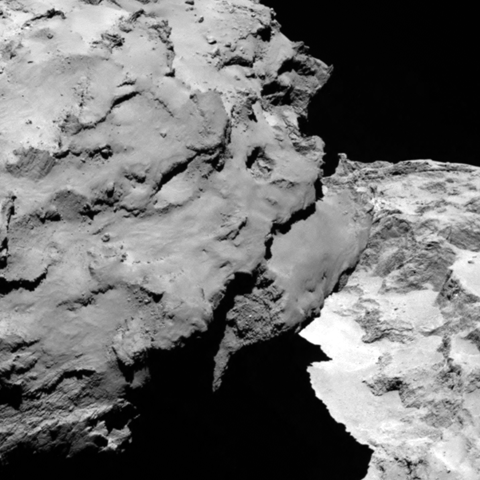
The image was taken from a distance of 120 km and the image resolution is 2.2 metres per pixel. Credit: ESA/Rosetta/MPS for OSIRIS Team MPS/UPD/LAM/IAA/SSO/INTA/UPM/DASP/IDA
Rosetta and Philae will also search for organic molecules, nucleic acids and amino acids, the building blocks for life as we know it by sampling and analyzing the comets nucleus and coma cloud of gas and dust.
“The first coma sampling could happen as early as next week,” said Matt Taylor, ESA’s Rosetta project scientist on the webcast.
“Is this double-lobed structure built from two separate comets that came together in the Solar System’s history, or is it one comet that has eroded dramatically and asymmetrically over time? Rosetta, by design, is in the best place to study one of these unique objects.”
After thoroughly mapping the comet, the team will command Rosetta to move even lower to 50 km altitude and then even lower to 30 km and less.
The scientists and engineers will search for up to five possible landing sites for Philae to prepare for the touchdown in mid-November 2014.
“We want to characterize the nucleus so we can land in November,” said Taylor. “We will have a ringside along with the comet as it moves inwards to the sun and then further out.”
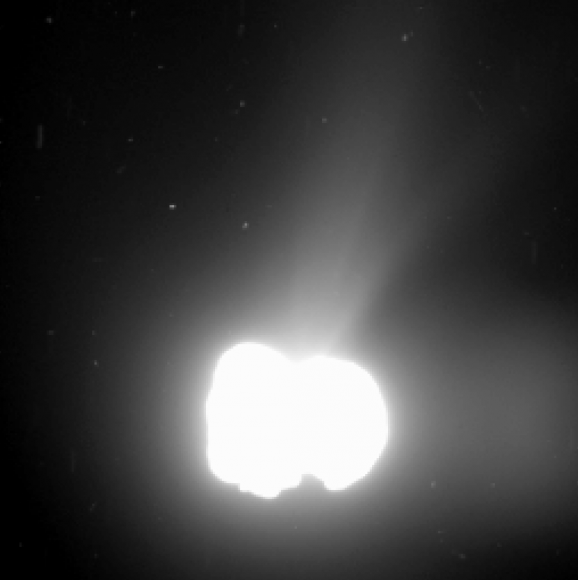
Studying comets will shed light on the history of water and life on Earth.
“We are going to places we have never been to before,” said Jean-Jacques Dordain, ESA’s Director General during the webcast.
“We want to get answers to questions to the origin to water and complex molecules on Earth. This opens up even more new questions than answers.”

Watch for updates.
Stay tuned here for Ken’s continuing Rosetta, Curiosity, Opportunity, Orion, SpaceX, Boeing, Orbital Sciences, commercial space, MAVEN, MOM, Mars and more Earth and Planetary science and human spaceflight news.
……..
Read my Rosetta series here:
Rosetta on Final Approach to Historic Comet Rendezvous – Watch Live Here
Rosetta Probe Swoops Closer to Comet Destination than ISS is to Earth and Reveals Exquisite Views
Rosetta Orbiter less than 500 Kilometers from Comet 67P Following Penultimate Trajectory Burn
Rosetta Closing in on Comet 67P/Churyumov-Gerasimenko after Decade Long Chase


